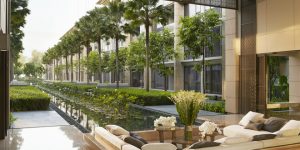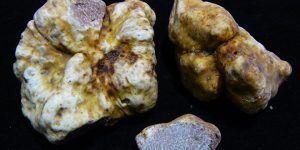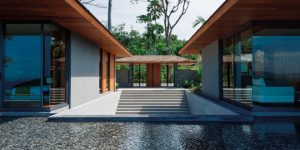Exhibition: NUS Museum presents Manit’s ‘Thai Masters of Photography’
A new exhibition at NUS Museum by Manit Sriwanichpoom articulates the history of Thai photography
What is the history of Thai photography? Who are the masters and what are the criteria to ascertain who they are? The resounding lack of answers to these questions formed the impetus for renowned Thai photographer Manit Sriwanichpoom’s research project, ‘Rediscovering Forgotten Thai Masters of Photography’. Running from 15 March to July 2018 at the NX1 Gallery of the NUS Museum, the exhibition presents the works of seven Thai photographers through a display of 247 remastered prints.
The project, first exhibited at the Bangkok University Gallery in September 2015, was conceived in 2010 with the aims of filling in the gaps in academic research on Thai photography. Often regarded through the lenses of the West, the history of Thai photography that traces its genealogy back to the Siam kingdom circa 1845 has been largely ignored. Manit explains that as a result, his project is an attempt to wrestle with the problem of “breathing air through the white man’s nose”. By furnishing historical Thai photographic narratives with specifically Thai axioms of the art form, Manit shifts the prevailing Western dominance over such narratives to the local photographic community.

Buddhadasa Bhikkhu, ‘Ananta’. Image courtesy Manit Sriwanichpoom.
Manit’s approach to selecting the masters goes beyond conventional frameworks of what characterises good photography. Almost as a response to the lack of historical records, the works are culled together to form a comprehensive education on the complexity that is Thai culture. An approximate set of both technical and substantial factors were examined by Manit in his search. As he states, amongst these were “outstanding content, the perspective, the camera angle, the photographic technique, the courageousness of the creativity in the social context of their lifetime; as well as each person’s understanding and use of the medium of photography in their self-expression, and the work’s anthropological and sociological relevance and value.” By setting the time frame from 1932 onwards as well, Manit delves explicitly into a modern past, marked by the Siamese revolution which witnessed Thailand’s movement into democracy and greater technological advancement, and which continues to linger in the nation’s consciousness today.

ML Toy Xoomsai, ‘#25’, date unknown. Image courtesy Manit Sriwanichpoom.
A cursory glance at the seven photographers chosen as the Thai masters reveals each photographer’s clear dedication to establishing his craft in his own personal corner of Thai culture. Here, they are displayed with stunning contrasts in subject matter. A prominent highlight in the selection is the unconventional Buddhist monk Buddhadasa Bhikkhu, who captured contemplative scenes composed alongside dharma-teaching poems that attempted to encapsulate the essence of Buddhist teachings. Juxtaposed against this is ML Toy Xoomsai, whose focus on nude photography posed a defiant stricture against the then-fascist state and its imposed social order while exploring the depths of Thai female beauty.

S.H. Lim, ‘Phusadee Anukkhamontri’, 1967. Image courtesy Manit Sriwanichpoom.
Even in the realm of portraiture, each master photographer stands within his own formidable and distinct creative processes. S. H. Lim, a photographer for many well-known Thai publications, captured the glory-days of Thai cinema and beauty contests post-1957 by directing a gaze of admiration towards the iconic women of the screen. Liang Ewe on the other hand, provides the modern audience with a treasure trove of invaluable social and cultural heritage: the plethora of individual portraits taken clue modern viewers into the diverse lives of the inhabitants of Phuket in the 60s, along with their various customs and practices. Pornsak Sakdaenprai brought portraiture to new heights as well. His fantastical shots of rural villagers in garb that harken towards the romanticised appeal of Luk Thung (Thai country music), reflects with amusing accuracy the transitions that rural Thailand took towards modernisation in the 60s.
Documenting scenes of common everyday life are ’Rong Wong-Savun and Saengjun Limlohakul. ’Rong’s modern, experimental style challenged the convention on compositional rules at the time, while making extraordinary the ordinary lives of the Thai peoples both in the cities and villages. Heading off in a divergent tangent, Saengjun’s photography was driven by a desire to record everything in Phuket. As such, he devoted his photography practice to immortalising his hometown of Phuket in the 60s, from the colourful lives of its citizens to the hectic events that constituted their days.

’Rong Wong-Savun, ‘Rama I Bridge’, 1958. Image courtesy Manit Sriwanichpoom.
A significant highlight of the exhibition is the engaging and unassuming nature of photography which is the sole medium introduced in the display. In fact, coupled with Manit’s emphasis on the democratic aspect of photography in his curatorial processes, the enduring relevance of the project is secured in Thai history. As he says, “Photography is very close to people. It is a medium that they feel comfortable and familiar with. They don’t feel like this is high art, but instead, feel that this is popular art that they feel close to, especially because they don’t need a lot of knowledge to understand it. I want people to look beyond the photograph and connect themselves to the contexts of the photographs.” By recommending these seven photographers as the masters of Thai photography to the public, Manit does not hope to set in stone who and what constitutes the authorities on the medium. Rather, he hopes to kickstart a national conversation on Thai photography, and compel his people to take ownership of their art and history.

Liang Ewe, 1962, glass negative. Image courtesy Manit Sriwanichpoom.
‘Rediscovering Forgotten Thai Masters of Photography’ is thus, both an act of empowerment and a historical investigation. By piecing together an assortment of varied perspectives in photography, Manit invites the audiences to grasp at the core of a deeper and richer understanding of present society through its collective past composed of diverse and fluid subjectivities. With a history that is constantly in flux and intimately shaping the future, the foundation for Manit’s ultimate goal of continuing official and scholarly work into Thai photographic history beyond the current exhibition is laid out with the hopes of more stimulating material to come.
More information at museum.nus.edu.sg.









